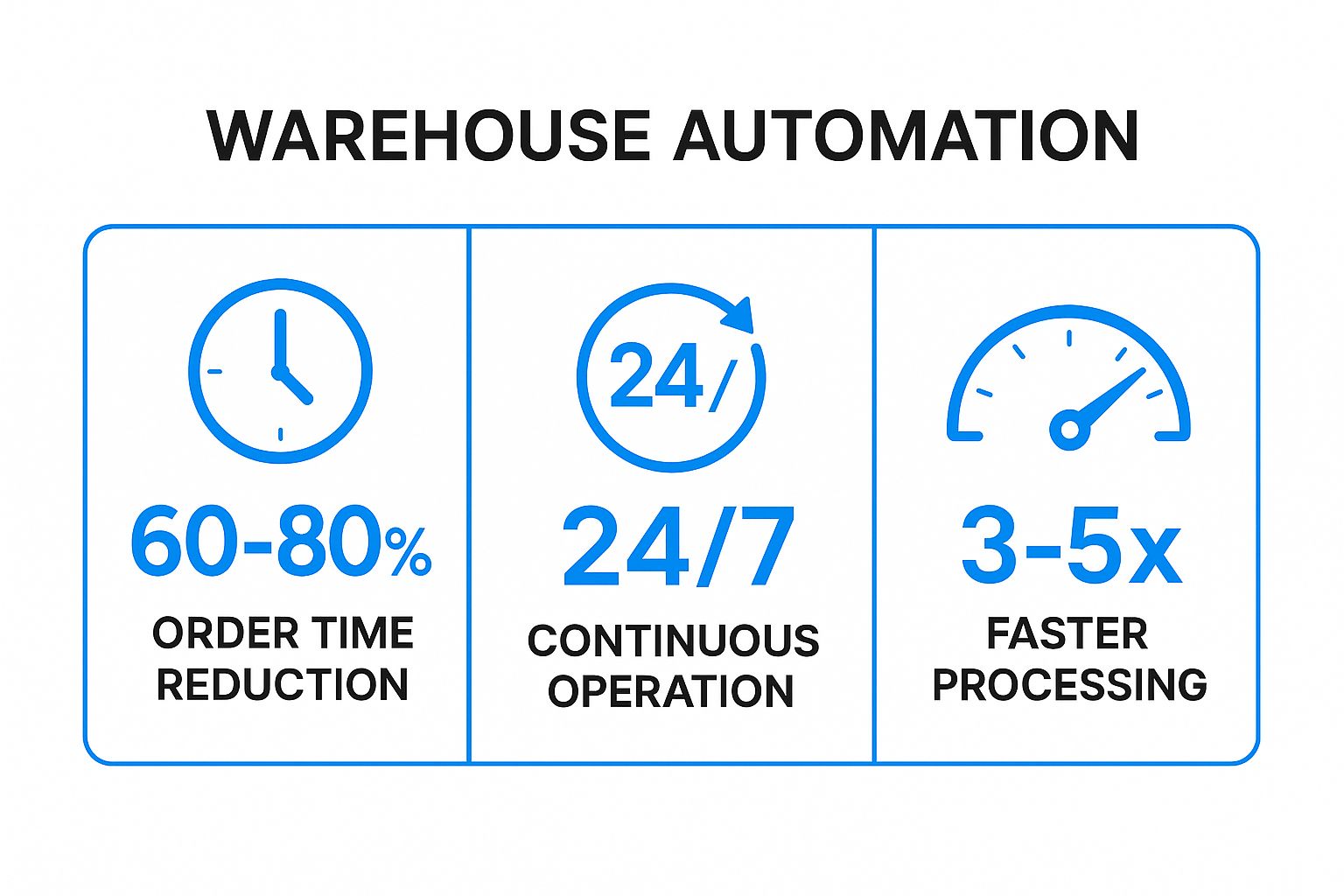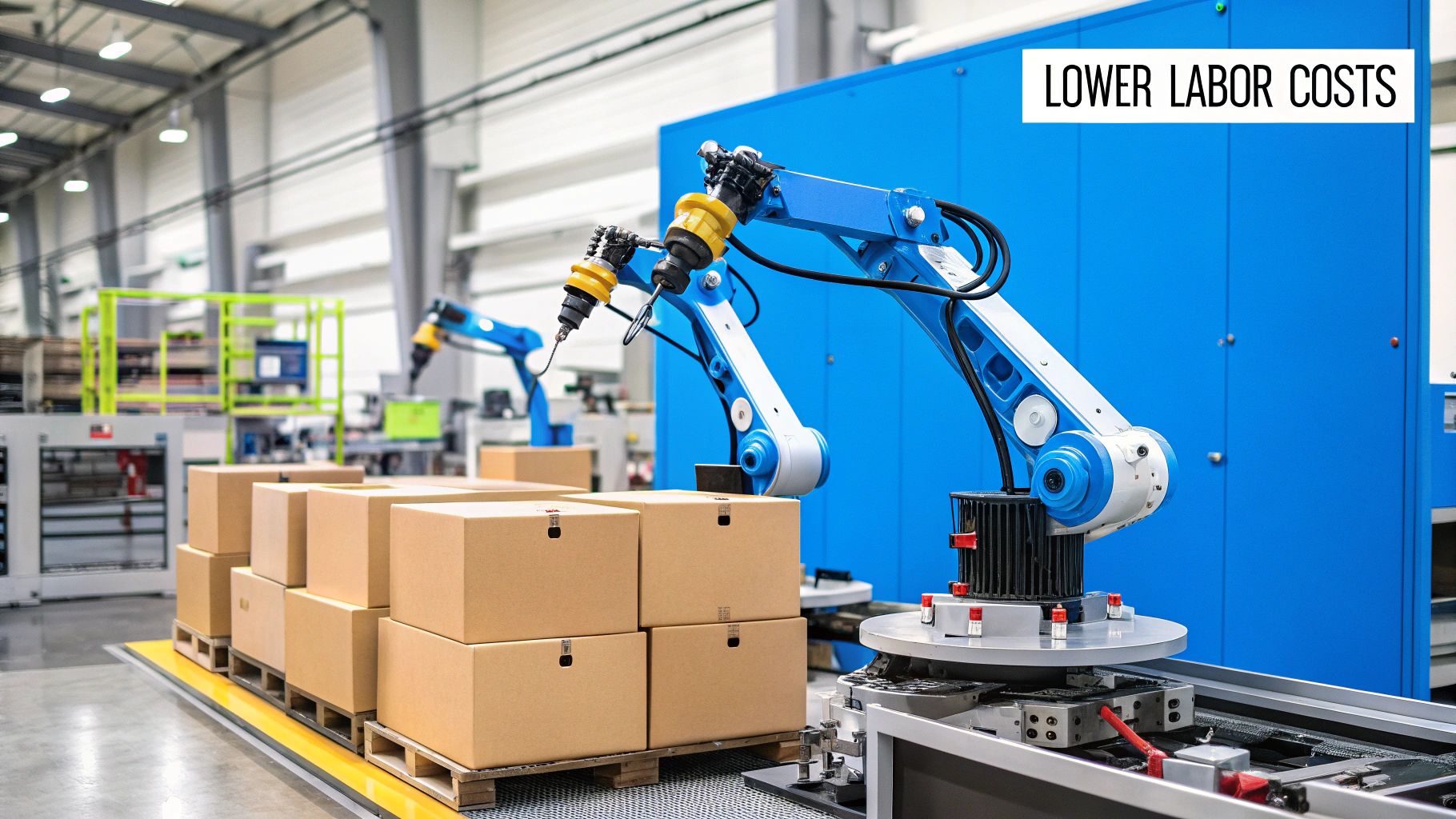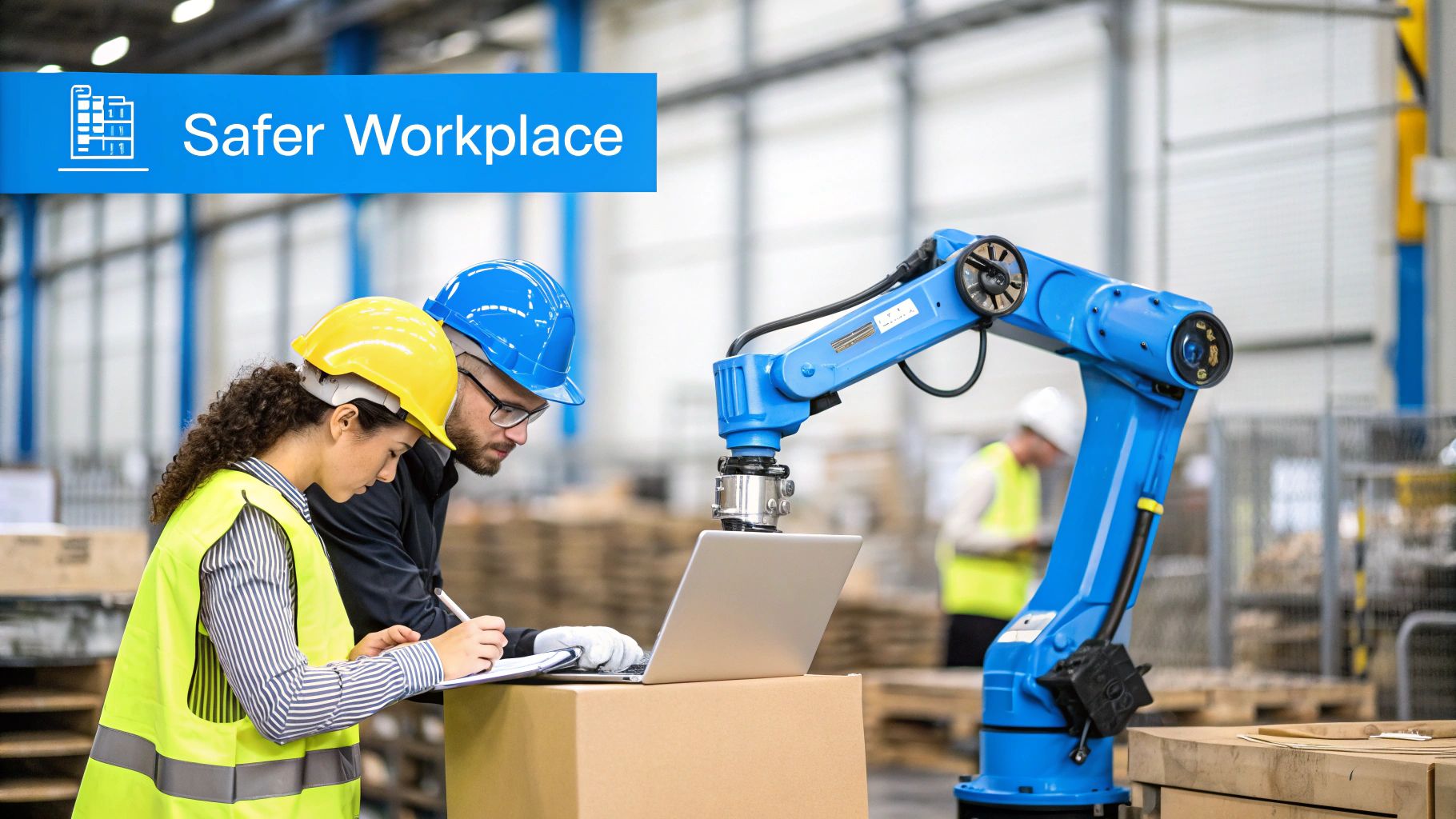In today's fast-paced e-commerce landscape, keeping up isn't enough; you need to stay ahead. As customer expectations for speed and precision skyrocket, the traditional warehouse model struggles to cope. This is where modern technology steps in, transforming warehouses from manual labor hubs into highly efficient, intelligent nerve centers. Understanding the core warehouse automation benefits is no longer just for enterprise-level giants; it's a critical strategic advantage for any growing brand. From slashing order processing times to creating a safer work environment, automation offers a multi-faceted solution to the most pressing logistics challenges.
The impact of smart automation extends beyond the four walls of the warehouse, playing a critical role in optimizing overall logistics operations and driving significant competitive advantage. In this comprehensive guide, we will break down the eight most impactful benefits that directly address the pain points of modern fulfillment. We'll provide practical examples and actionable insights to help you see how leveraging automation, either in-house or through a tech-forward 3PL partner like Simpl Fulfillment, can revolutionize your supply chain and fuel sustainable growth. Let's explore how these systems deliver tangible results.
One of the most immediate and impactful warehouse automation benefits is a dramatic increase in operational speed and efficiency. By replacing manual processes with automated systems, warehouses can operate continuously, 24/7, without the natural limitations of human labor, such as breaks, shift changes, or fatigue. These systems are engineered for one primary purpose: to move goods from point A to point B as quickly and accurately as possible.
The result is a significant acceleration across all core warehouse functions. Automated picking systems, like robotic arms or goods-to-person (G2P) bots, can retrieve items 3-5 times faster than human workers. This acceleration extends to sorting, packing, and shipping, creating a streamlined, high-velocity workflow that drastically reduces order fulfillment times. For example, Amazon's use of Kiva robots famously slashed its "click-to-ship" cycle from hours down to mere minutes. Similarly, automated grocery retailer Ocado processes over 65,000 orders weekly with minimal human intervention, showcasing the sheer scale and speed automation enables.
This infographic highlights the quantifiable gains in speed and uptime that businesses can expect.

As the data shows, the ability to process orders faster while operating continuously transforms a warehouse from a cost center into a powerful competitive advantage. The gains in efficiency and speed seen in warehouse automation are mirrored across various sectors; for more insights, consider the broader applications of manufacturing and industrial automation solutions.
Key Insight: At Simpl Fulfillment, we leverage automation to ensure your orders are processed with industry-leading speed. By automating repetitive tasks, we free up our expert team to focus on quality control and complex fulfillment challenges, giving your brand the speed it needs to delight customers.
For businesses looking to implement these strategies, it's crucial to approach automation thoughtfully. Start with a pilot program in a specific zone to measure impact, ensure deep WMS integration, and thoroughly train staff on new systems. To dive deeper into specific tactics for boosting your facility's output, you can explore our guide on how to improve warehouse efficiency effectively.
Another of the core warehouse automation benefits is a profound improvement in accuracy, leading to a near elimination of costly human errors. Manual operations are inherently susceptible to mistakes like mis-picks, incorrect labeling, and inventory count discrepancies. Automated systems, however, leverage advanced scanning technology, robotics, and integrated software to execute tasks with near-perfect precision, often achieving accuracy rates of 99.5% or higher.

This level of precision is driven by systems that rely on data, not human memory or eyesight. Companies like Cognex Corporation and Zebra Technologies have pioneered machine vision and scanning solutions that validate every step of the fulfillment process. The impact is transformative. For example, DHL reported reaching 99.9% picking accuracy in its automated warehouses by using vision-guided robotics. Similarly, Zara's automated distribution centers cut mislabeling errors by an incredible 98%, while Nike's automated facilities saw inventory discrepancies plummet from a high of 8% down to just 0.2%. These gains prevent the significant downstream costs associated with returns, reverse logistics, and customer dissatisfaction.
This infographic details the dramatic reduction in errors that businesses can achieve through automation.
Key Insight: At Simpl Fulfillment, our warehouse automation is designed for accuracy first. Every order is subject to multiple digital and physical verification checks, ensuring that what your customer ordered is exactly what they receive. This obsession with accuracy protects your brand's reputation and bottom line.
To successfully leverage automation for greater accuracy, businesses must establish clear operational standards. This includes implementing comprehensive barcode labeling across all SKUs, performing regular calibration of all scanning and weighing equipment, and establishing clear exception-handling procedures for the rare instances an error does occur. For more on creating robust operational frameworks, review our insights on developing a fulfillment strategy.
A core advantage of embracing warehouse automation is the substantial reduction in labor-related expenditures. Automation systems are designed to handle the most physically demanding and repetitive tasks, such as picking, packing, sorting, and transporting goods, which dramatically reduces the dependency on manual labor. Research from firms like Boston Consulting Group shows that businesses can cut labor requirements by 40-70% in targeted areas, leading to direct savings on wages, benefits, recruitment, and training costs.

This shift not only trims operational expenses but also provides a strategic solution to persistent labor shortages and high turnover rates common in the warehousing industry. For instance, e-commerce giant JD.com operates highly automated warehouses with 80% fewer employees than traditional facilities, all while achieving superior productivity. Similarly, Kroger’s automated fulfillment centers, powered by Ocado's technology, decreased labor needs by 60% and significantly boosted order capacity. These examples illustrate how automation creates a more resilient and cost-effective operational model.
The ability to control and reduce labor expenses is one of the most compelling warehouse automation benefits, turning a major cost center into a predictable, optimized expense.
Key Insight: At Simpl Fulfillment, we strategically implement automation to manage labor costs effectively. This allows us to offer competitive pricing while maintaining a highly skilled workforce focused on complex tasks that require human ingenuity, ensuring your products are handled with care and precision without inflated labor overhead.
To successfully leverage automation for cost savings, companies should begin by targeting the most labor-intensive and high-turnover roles first. It's essential to calculate the total cost of ownership (TCO) for new technology, including maintenance and future upgrades, to ensure a clear return on investment. Furthermore, developing robust retraining programs helps manage the workforce transition smoothly, turning potential job displacement into an opportunity for upskilling.
A paramount benefit of warehouse automation is the significant improvement in workplace safety. Warehouses are traditionally high-risk environments, filled with manual tasks like heavy lifting, operating powerful machinery, and working at heights, all of which contribute to a high rate of workplace injuries. Automation directly addresses these dangers by delegating the most physically demanding and hazardous jobs to machines, creating a much safer operational space for human employees.

The impact is transformative. Companies that embrace automation often see a dramatic reduction in incidents related to musculoskeletal injuries, forklift collisions, and falls. For instance, BMW's automated warehouses reported an 85% reduction in workplace injuries after implementing robotic systems for materials handling. Similarly, UPS automated facilities saw a 90% decrease in back injuries through automated package handling, and Procter & Gamble eliminated forklift accidents entirely in its fully automated zones. This not only protects the workforce but also leads to lower insurance premiums and better compliance with OSHA regulations.
This shift allows human workers to move into roles focused on oversight, quality control, and system management, which are inherently safer and less physically strenuous. Beyond automation, focusing on fundamental aspects like robust health and safety protocols is crucial for a secure and productive warehouse environment.
Key Insight: At Simpl Fulfillment, safety is a core component of our operational philosophy. By automating strenuous tasks like palletizing and depalletizing, we protect our team from injury and ensure our facility runs smoothly and reliably. This allows us to maintain high standards of service without compromising the well-being of our staff.
To successfully integrate automation for safety, businesses should conduct thorough risk assessments before implementation to identify key hazards. It is also vital to establish clear safety zones for human-robot interaction and implement comprehensive lockout/tagout procedures for machine maintenance. Regular safety audits are essential to ensure all systems and protocols remain effective.
Another powerful warehouse automation benefit is the ability to reclaim and maximize every cubic foot of facility space. Traditional warehouse layouts, designed for human workers and forklifts, require wide aisles and have height limitations. Automated systems fundamentally change these requirements, enabling hyper-dense storage solutions that can dramatically increase capacity within the same physical footprint. This is a game-changer for businesses in expensive real estate markets or those facing rapid growth.
Systems like Automated Storage and Retrieval Systems (AS/RS) use cranes and shuttles to operate in narrow aisles, reaching heights far beyond manual capabilities. This vertical approach can increase storage capacity by 40-85%. For example, pharmaceutical giant McKesson leveraged vertical lift modules to improve its space efficiency by a remarkable 60%. Similarly, Zappos increased its storage density by 40% while simultaneously reducing picking times, proving that space optimization and operational speed can be achieved together. Leaders in this space, like Swisslog and Kardex Remstar, have pioneered these technologies.
Key Insight: At Simpl Fulfillment, our facilities are designed with smart space utilization in mind. By combining strategic racking with automated inventory management, we ensure your products are stored efficiently, reducing your storage costs and ensuring scalability as your business grows.
To effectively implement space-saving automation, you must start with a thorough analysis of your inventory and growth projections. This data will inform the design of your AS/RS or VLM system. For a comprehensive look at maximizing your facility's potential, explore our guide on warehouse space optimization for success.
Among the most powerful warehouse automation benefits is the ability to achieve near-perfect inventory control and real-time visibility. Manual inventory tracking is notoriously prone to human error, leading to costly discrepancies, stockouts, and overstocking. Automated systems, however, integrate directly with a Warehouse Management System (WMS) to create a single source of truth, tracking every item's movement from receiving to shipping with unparalleled accuracy. This provides a live, dynamic view of all stock levels across the entire facility.
The result is a transformative shift from reactive to proactive inventory management. Automated cycle counting, often performed by drones or AMRs, ensures continuous data accuracy without disrupting operations, helping businesses achieve 99.5%+ inventory accuracy. This precision minimizes stockouts that lead to lost sales and reduces the capital tied up in excess inventory. For instance, Coca-Cola’s automated distribution centers boosted inventory accuracy from 95% to 99.8%, while Unilever's smart warehouses leveraged optimization to cut inventory carrying costs by 25%.
Key Insight: At Simpl Fulfillment, we understand that accurate inventory is the foundation of a successful e-commerce brand. Our automated systems provide real-time visibility into your stock, ensuring the inventory numbers you see are the numbers we have on the shelf. This precision prevents overselling and keeps your customers happy.
For brands aiming to eliminate inventory headaches, a deep understanding of these systems is crucial. To gain a comprehensive overview of the strategies and tools involved, you can explore our guide to master real-time inventory management.
One of the most strategic warehouse automation benefits is the ability to achieve unprecedented scalability and flexibility. Traditional warehouses are rigid; expanding capacity often requires significant capital investment and long construction lead times. Modern automation systems, however, are frequently built with modular designs, allowing businesses to scale operations up or down in direct response to fluctuating demand, seasonal peaks, and long-term growth without requiring a complete infrastructure overhaul.
This agility allows a company to adapt to market dynamics swiftly and efficiently. For instance, retailers can dynamically increase their fulfillment capacity to handle holiday rushes and then scale back down to normal levels, optimizing operational costs. Target's automated distribution centers are engineered to adjust throughput by as much as 150% to manage demand swings. Similarly, European e-commerce giant Zalando utilizes flexible automation systems that accommodate seasonal capacity variations of up to 40%, ensuring they can meet customer expectations during the busiest shopping periods. This on-demand capacity is a game-changer for growing businesses.
Key Insight: At Simpl Fulfillment, we use a scalable operational model that gives your business the flexibility to grow without limits. You gain access to our advanced automated infrastructure, allowing you to handle a 300% surge in Black Friday orders as easily as a slow Tuesday in February. This eliminates the risk of over-investing in your own infrastructure or being unable to meet customer demand.
For growing brands, leveraging a 3PL partner with this built-in scalability is a powerful strategy. It allows you to focus on marketing and product development while your logistics partner handles the operational scaling. To see how this impacts your bottom line, you can explore the key third-party logistics benefits for growth.
Beyond physical movement, a core warehouse automation benefit is the immense volume of operational data it generates. Automated systems are equipped with sensors and tracking capabilities that capture every action, creating a rich digital record of warehouse activities. When analyzed, this data provides unparalleled business intelligence, transforming operations from reactive to predictive and enabling continuous, data-driven improvement.
This intelligence allows managers to move beyond guesswork and make strategic decisions based on hard evidence. By leveraging data analytics, companies can identify subtle bottlenecks, forecast demand with greater accuracy, and optimize inventory placement for maximum efficiency. For example, global shipping giant Maersk uses AI analytics in its automated terminals to refine container handling, boosting efficiency by 30%. Similarly, Johnson & Johnson leverages warehouse data to fine-tune its inventory strategy, successfully reducing carrying costs by 20% through precise, data-informed adjustments.
Key Insight: At Simpl Fulfillment, our warehouse management system doesn't just manage inventory; it creates a continuous feedback loop. We analyze fulfillment data to optimize picking paths, manage labor allocation, and identify opportunities for improvement, ensuring your operations become smarter and more efficient over time.
The journey through the world of warehouse automation benefits reveals a clear and compelling narrative. We've moved beyond abstract concepts and delved into the tangible impacts that automation delivers, from the lightning-fast processing of orders to the meticulous accuracy that eliminates costly errors. Each benefit we’ve explored, whether it's optimizing every square foot of storage, ensuring a safer work environment, or providing the real-time data needed for smart decisions, is not just an operational upgrade. It’s a strategic advantage.
These advantages collectively build a more resilient, responsive, and profitable business. Imagine your fulfillment operations scaling seamlessly during your busiest sales period without a drop in performance. Picture having complete visibility into your inventory, preventing stockouts and overstock situations with data-driven precision. This is the new standard for competitive e-commerce, and it's powered by automation. The most critical takeaway is that these warehouse automation benefits are not isolated improvements; they are interconnected, creating a powerful flywheel effect that propels your brand forward.
Mastering these concepts is no longer optional for ambitious DTC brands. In a marketplace where customer expectations for speed and reliability are at an all-time high, your fulfillment capability is a direct reflection of your brand promise. A delayed or incorrect order isn't just a logistical hiccup; it's a damaged customer relationship.
Leveraging automation transforms your supply chain from a cost center into a powerful tool for customer acquisition and retention. The key is to recognize that you don't need to build this sophisticated ecosystem from the ground up. The immense capital, time, and expertise required can be prohibitive for growing businesses.
The most strategic and efficient path forward is to partner with a third-party logistics (3PL) provider that has already made these critical investments. By aligning with a tech-forward 3PL, you gain immediate access to a state-of-the-art, automated infrastructure without the upfront financial burden or operational risk.
This approach allows you to:
The future of e-commerce is not just about having a great product; it's about delivering it flawlessly. By embracing the power of warehouse automation through a strategic partnership, you position your business not just to survive, but to thrive in the competitive landscape ahead, ensuring every customer experience is exceptional.
Ready to unlock these warehouse automation benefits for your brand without the massive upfront investment? Partner with Simpl Fulfillment to leverage our state-of-the-art automated fulfillment network and see how our technology can drive your growth. Get your free quote today and turn your logistics into a competitive advantage.